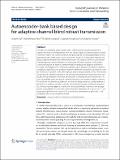Autoencoder-bank based design for adaptive channel-blind robust transmission
Author(s)
Safi, Hossein; Akbari, Mohammad; Vaezpour, Elaheh; Parsaeefard, Saeedeh; Shubair, Raed M.
Download13638_2021_Article_1929.pdf (1.797Mb)
Publisher with Creative Commons License
Publisher with Creative Commons License
Creative Commons Attribution
Terms of use
Metadata
Show full item recordAbstract
Abstract
The idea of employing deep autoencoders (AEs) has been recently proposed to capture the end-to-end performance in the physical layer of communication systems. However, most of the current methods for applying AEs are developed based on the assumption that there exists an explicit channel model for training that matches the actual channel model in the online transmission. The variation of the actual channel indeed imposes a major limitation on employing AE-based systems. In this paper, without relying on an explicit channel model, we propose an adaptive scheme to increase the reliability of an AE-based communication system over different channel conditions. Specifically, we partition channel coefficient values into sub-intervals, train an AE for each partition in the offline phase, and constitute a bank of AEs. Then, based on the actual channel condition in the online phase and the average block error rate (BLER), the optimal pair of encoder and decoder is selected for data transmission. To gain knowledge about the actual channel conditions, we assume a realistic scenario in which the instantaneous channel is not known, and propose to blindly estimate it at the Rx, i.e., without any pilot symbols. Our simulation results confirm the superiority of the proposed adaptive scheme over existing methods in terms of the average power consumption. For instance, when the target average BLER is equal to
$$10^{-4}$$
10
-
4
, our proposed algorithm with 5 pairs of AE can achieve a performance gain over 1.2 dB compared with a non-adaptive scheme.
Date issued
2021-03-06Department
Massachusetts Institute of Technology. Department of Electrical Engineering and Computer Science; Massachusetts Institute of Technology. Research Laboratory of ElectronicsPublisher
Springer International Publishing
Citation
EURASIP Journal on Wireless Communications and Networking. 2021 Mar 06;2021(1):47
Version: Final published version